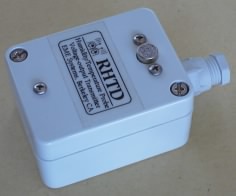RHTD relative humidity/temperature
probe
*** EME SYSTEMS NO LOGER CARRIES THE RHTD ***
*** PLEASE CALL US AT (510) 848-5725 TO DISCUSS OTHER OPTIONS ***
The RHTD from EME Systems is built around the Honeywell/Microswitch/HY-CAL HIH3602C monolithic IC humidity sensor. This sensor element is exceptionally rugged, well suited for applications in harsh outdoor environments. It is protected by a hydrophobic sintered metal filter that can be scrubbed clean with water and a stiff brush. Under the filter is a sensor element constructed with muliple protective layers of polymer and monolayer platinum. The IH3602C also contains a RTD temperature sensor in intimate proximity with the humidity element, to facilitate temperature compensation and calculation of derived quantities such as dew point and vapor pressure. The EME RHTD improves upon the IH3602C by mounting it in a polycarbonate enclosure along with a stable power supply and circuitry to condition the humidity and temperature signals for voltage outputs. The IH3602C sensor element is replaceable. Both the humidity and temperature signals are voltages compatible with many data loggers, including the EME Systems OWL2c It is an excellent choice for any kind of agricultural or environmental research.
 Enclosure,
polycarbonate
2.5"l x 2"w x 1.4"h plus gland nut for cable entry. Weight, 4
ounces. Mounting
template. The IH3602 replaceable sensor element is
protected by a sintered hydrophobic metal filter, and projects
through an O-ring in the polycarbonate case. The calibration
constants are noted on a calibration label on the side of the
case. The sensor element is socketed and can be easily
replaced if necessary. The calibration certificate from HyCal
is to be found inside the enclosure.
Enclosure,
polycarbonate
2.5"l x 2"w x 1.4"h plus gland nut for cable entry. Weight, 4
ounces. Mounting
template. The IH3602 replaceable sensor element is
protected by a sintered hydrophobic metal filter, and projects
through an O-ring in the polycarbonate case. The calibration
constants are noted on a calibration label on the side of the
case. The sensor element is socketed and can be easily
replaced if necessary. The calibration certificate from HyCal
is to be found inside the enclosure.
Specifications:
Humidity output:
- 0.8 volts to 4.0 volts nominal for 0.0 to 100% humidity.
- Each probe comes with a calibration certificate showing the calibration data.
- Total compensated accuracy ±2% at 0 &endash; 100% RH at 25°C
- Temperature compensation required: no compensation
required at 0 %RH
-0.22%RH/°C at 100% RH for temperatures > 0°C
+0.33%RH/°C at 100% RH for temperatures <0°C
please see here for details. - Operating temperature, -25°C to +100°C.
- Repeatability ±0.5%RH.
- Linearity: ±0.5% typical

Temperature Output:
- Platinum RTD, standard alpha=0.385 response curve.
- 0-5 volts for -25'C to +100'C, ±1.0°C without linearization
- 40 millivolts per degree Celsius output.
- Calibration points 0.0°C and 50.0°C, ±0.5'C
- Supply Volts: 6 to 18 Volts DC
- Supply Voltage variation effect: less than 0.01% per Volt
- Supply Current: less than 2 mA
- Temperature variation effect: less than 0.01% per 'C
- Output connections: Common, +7-18vdc, humidity sig temperature signal
- Output impedance: 1000ohm
Application:
The block of four green screw-down terminals inside the enclosure allows connections to a data logger or contoller. There are connections for the +6 to 18 volt power supply, the humidity and temperature output signals, and common. The cable passes through a gland nut in the side of the case.
The humidity signal produced by the RHTD is simply a buffered replica of the signal from the IH3602 sensor element. The signal is not amplifedor shifted. A calibration equation of the form,
%rh = S* (volts-Vo)
is printed on the calibration label on the outside of the RHTD enclosure. This equation with its constants particular to the individual RHTD unit, and should be entered in your software. An temperature correction is necessary for the best accuracy, especially in humid situations. This correction is of the form,
%RH := %rh*(90.2 + 0.4605*T - 0.00307*T2 )/100
where the %RH on the right hand side is the uncorrected value from the first equation, and where T is the temperature in degrees Celsius. That applies for temperatures above freezing, T>0.
When T is less than freezing, -25<T<0, a different equation applies:
T=ABS(T) ' make T positive %RH := %rh*(90.2 + 1.314*T - 0.018*T2)/100
More information about the temperature compensation is found on a separate technical page on programming and temperature compensation.
The RHTD is calibrated so that the output voltages will be
1.00 volts at 0.0°C and 3.00 volts at 50.0°C. The first-order
equation for calculation of temperature is
°C = Volts * 25 - 25
If the RTD characteristic were exactly linear, then -25°C
would fall at 0.0 volts and +100°C would fall at 5.0
volts. But since the RTD characteristic is slightly nonlinear,
there will be small errors at all temperatures except 0.0°C
and 50.0°C. The error is less than 0.2°C for
temperatures between 0.0 to 50.0, but it increases rapidly
outside that range. The instructions that come with the RHTD
suggest a quadratic correction formula where best accuracy is
needed
The RHTD manual comes with information on operation, programming the equations, recalibration and troubleshooting.